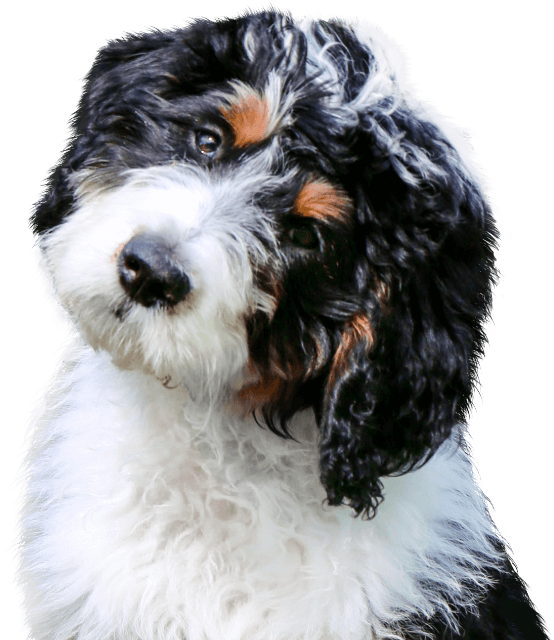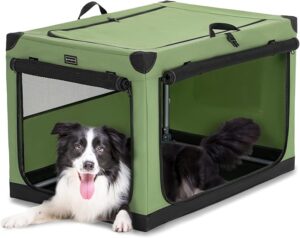Paws, Tents, and Wagging Tails: Your Guide to Camping with Your Dog
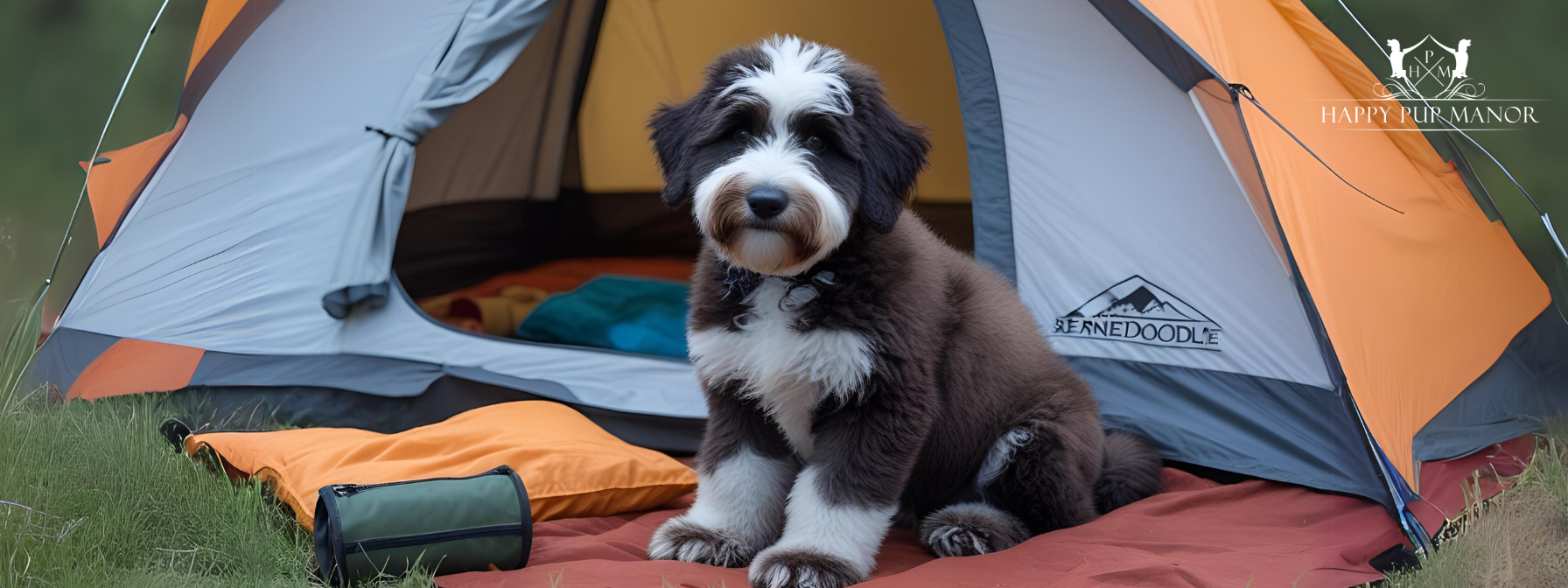
Paws, Tents, and Wagging Tails: Your Guide to Camping with Your Dog
There is nothing quite like fresh air, starry skies, and the joy of sharing it all with your four-legged best friend. Camping with your dog can be an incredible bonding experience, but it does take a little planning to ensure both of you are safe and happy in the great outdoors.
As expert dog trainers at Happy Pup Manor, we are here to guide you through the essentials so your pup will love the adventure as much as you do!
Should You Take Your Dog Camping?
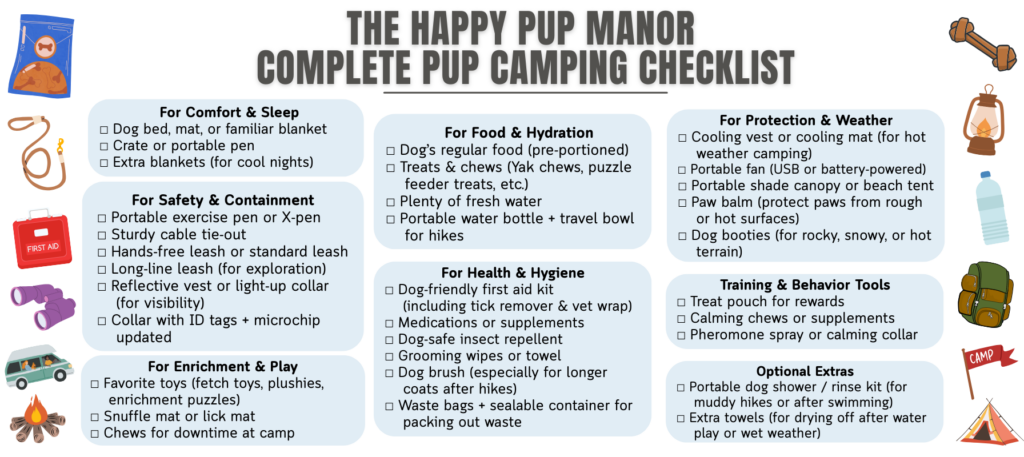
Yes, you should, as long as your dog is well-prepared. Many dogs thrive on the new sights, smells, and experiences that camping brings. Spending time outdoors can provide both mental stimulation and physical enrichment for your pup, deepening the bond between you both.
Before you pack the tent and leash, though, it is important to take an honest look at your dog’s temperament. Is camping stressful for dogs? It certainly can be, especially if your pup is naturally anxious or fearful of loud noises, strange environments, or encounters with other animals.
If your dog is sensitive to new situations, the camping environment, with its unfamiliar sounds like crackling fires, rustling wildlife, and fellow campers, can be overwhelming. In these cases, preparation is key.
We recommend gradual exposure and positive reinforcement training to help your pup feel comfortable and confident. like:
- Start by introducing your dog to a tent in your backyard
- Practice camping behaviors like settling on a mat
- Visit local parks to mimic the sounds and scents of nature
- Build up to short overnight trips before embarking on an extended adventure
Remember, camping should be enjoyable for both of you. If your dog is well-prepared, it can be a wonderful experience filled with wagging tails and happy memories.
For more insights on preparing for success, we recommend the American Kennel Club’s guide to camping with dogs.
What Do People Do with Their Dogs When They Go Camping?

When people go camping with their dogs, the goal is to keep them safe, happy, and engaged. Dogs love exploring new environments, but structure and routine help them feel secure. Some favorite activities include:
Hiking together on dog-friendly trails
Be sure to check local trail guidelines before heading out, as not all trails allow dogs. Pack plenty of water and snacks for your pup to keep them energized and hydrated during the hike. Pay attention to signs of fatigue or overheating, and take breaks as needed to keep your dog comfortable.
Relaxing at the campsite
Create a comfortable space for your dog with a familiar blanket, bed, or mat at your campsite. Having a designated area helps your dog feel secure and gives them a place to relax between activities. A shaded spot is especially important on warm days.
Playing enrichment games or fetch
Bringing along your dog’s favorite toys or puzzle games is a great way to keep them mentally stimulated while at camp. Interactive games like fetch or tug can help your dog burn off energy in a safe, controlled way. Puzzle toys or chews can also provide entertainment during quieter moments.
Swimming in designated dog-friendly lakes
Many dogs love the opportunity to swim and cool off in the water. Always check park rules to make sure dogs are permitted in the lake or swimming area. Supervise your pup closely around water, and bring a towel to dry them off afterwards to keep them comfortable and clean.
Snuggling by the campfire
After a full day of exploring, many dogs enjoy relaxing by your side at the campfire. Keep your dog close, either leashed or within a secure pen, to ensure their safety. The campfire setting can be a wonderful opportunity to unwind together and enjoy the evening.
Maintain familiar routines
In addition to these fun activities, try to maintain familiar routines, such as feeding times, potty breaks, and rest periods. A predictable schedule helps your dog stay calm and comfortable in the new camping environment. This consistency can make the entire trip more enjoyable for both of you.
Before you choose your destination, remember to check the pet policies of the campground. Not all campgrounds allow dogs, and some have specific leash requirements or restricted areas. Sites like BringFido are helpful for finding dog-friendly campgrounds and nearby pet-friendly activities.
What Do People Do with Dogs When They Travel?

If you are traveling to a camping destination, it is important to plan your road trip around your pup’s needs. Dogs do best when they can move around and take regular breaks. Aim to stop every two to three hours to allow your dog to stretch their legs, have a potty break, and drink water.
Pack familiar items for comfort
When packing for the drive, be sure to bring plenty of fresh water, your dog’s usual food, and a few familiar comfort items like their bed or favorite blanket. Familiar scents and textures can help reduce anxiety and make your dog feel more at home in both the car and at the campsite. These small touches can go a long way in helping your pup adjust to new environments.
Provide a secure space in the car
A comfortable and secure space in the car is also important for safe travel. Many pet owners use a crate, travel harness, or booster seat to keep their dog safely restrained while driving. Lining the crate or seat with a familiar blanket gives your dog a cozy place to settle in for the ride.
Break up long trips with overnight stays
If your drive is especially long, consider scheduling a day or two at dog-friendly accommodations along the way. A short overnight stay in a hotel or vacation rental allows your dog to rest and adjust to the travel routine. This can make the entire trip more enjoyable and less stressful for both you and your pup.
Related Reading: Dog Outdoor Safety: How to Keep Your Pup Safe During Adventures
How to Keep Dogs Contained While Camping?
The most important factor when it comes to keeping your dog contained while camping is supervision. Even well-trained dogs can become startled by new sights, sounds, or wildlife. A dog that is left unattended or poorly secured could easily slip away or become tangled.
Even when using a short leash or tether, it is important to keep a close eye on your pup. Dogs can become wrapped around objects or caught in the tether if left alone.
Portable exercise pens or enclosed tents are often one of the safest and most comfortable choices for containment, especially when you are busy with camp tasks like cooking or setting up gear. These give your dog a bit more freedom to move around while still keeping them secure and out of harm’s way.
Use a portable exercise pen or X-pen
Lightweight and easy to pack, a portable exercise pen or X-pen creates a secure space for your dog at the campsite. It allows your pup some freedom to move while keeping them safely contained. This is especially useful when you are busy with camp chores or relaxing around the site.
Tether your dog with a sturdy leash
Secure the tie-out or leash to a stable object such as a picnic table, tree, or ground stake. Always supervise your dog when tethered, as leashes can become tangled or pose safety risks if left unattended. Tethering is best used when you are sitting nearby and able to keep a close watch on your pup.
Keep your dog in a secured crate or tent when resting
If your dog is crate-trained, bringing their crate along provides a safe and familiar place for them to rest. A secured crate or tent helps protect your dog from wildlife and prevents them from wandering at night. This also gives your pup a designated space to relax and recharge during your camping trip.
It’s also helpful to practice calm containment skills before your trip. You can start by setting up an exercise pen or crate at home or in the backyard, giving your dog a chance to get comfortable being in that space for short periods.
Related Reading: Finding the Right Crate Size For a Puppy
Where Should Dogs Sleep When Camping?

Your dog should always sleep inside your tent or camper with you. This helps them stay warm, dry, and safe from wildlife or other campers. Sleeping close to you also provides comfort and reduces anxiety, especially in an unfamiliar environment.
Set up a cozy sleeping spot
If you’re tent camping, set up a cozy spot for your dog with their bed, mat, or favorite blanket. Bringing familiar bedding from home helps your pup settle in more easily. If your dog is crate-trained, you can also bring a travel crate to give them a secure place to sleep inside the tent or camper.
Prepare for temperature changes
Be mindful of temperature changes at night. Even in summer, temperatures can drop significantly in the woods or mountains. Smaller dogs, seniors, and short-coated breeds may need an extra blanket or a light jacket to stay warm through the night.
Practice camping sleep routines
It’s a good idea to practice camping sleep routines before your trip. Try setting up the tent at home or in the backyard and encouraging your dog to nap or relax inside. This helps them feel comfortable when it’s time for the real adventure.
Related Reading: Sleepypod: The Pet Safety Must-Have
How Do You Tether a Dog While Camping?

When used correctly, tethering can give your dog a safe way to stay close while you relax at camp. The key is to always supervise and use equipment that keeps your pup secure and comfortable.
Here are safe ways to tether your dog while camping:
A sturdy cable tie-out
Use a cable tie-out secured to an immovable object, such as a tree, picnic table, or ground anchor. The cable should be long enough to give your dog room to move comfortably, but not so long that they risk becoming entangled in nearby obstacles.
A short leash attached to your camp chair
Use a short leash that you can attach to your camping chair or wear around your waist while you relax. This keeps your dog close by and allows you to monitor them at all times.
No matter which method you choose, never leave your dog tethered alone. Even a well-trained pup can quickly become tangled or startled by wildlife or other campers. Active supervision is essential to keeping your dog safe and happy at the campsite
It’s also wise to practice relaxed tethering skills at home before your trip. You can start by having your dog practice settling calmly on a mat or bed with a leash attached while you work nearby.
Related Reading: Choosing the Right Collar and Leash for Your Pup
What to Do with Dog Poop When Camping?

Managing your dog’s waste responsibly is an important part of Leave No Trace camping. Just like human waste, dog waste can contaminate water sources, attract wildlife, and disrupt the natural ecosystem if it’s not handled properly. Here’s what to do:
Pack out dog waste
Use sturdy, biodegradable poop bags to pack out dog waste. Bring extras, as bags can tear or get used up quickly during an active weekend outdoors.
Dispose of bags properly
Dispose of used bags in proper trash receptacles at the campground or trailhead. Never leave bags on the trail or tied to trees.
Never bury dog waste
Never bury dog waste, even in the backcountry. Dog waste can carry bacteria and parasites that affect local wildlife and water sources.
Bring a sealable container if needed
If your campsite or hiking area doesn’t have trash bins, plan ahead by bringing a sealable container, such as a large zip-top bag or a dog waste canister, to pack out waste until you find an appropriate place to dispose of it.
Does Camping with a Dog Attract Bears?
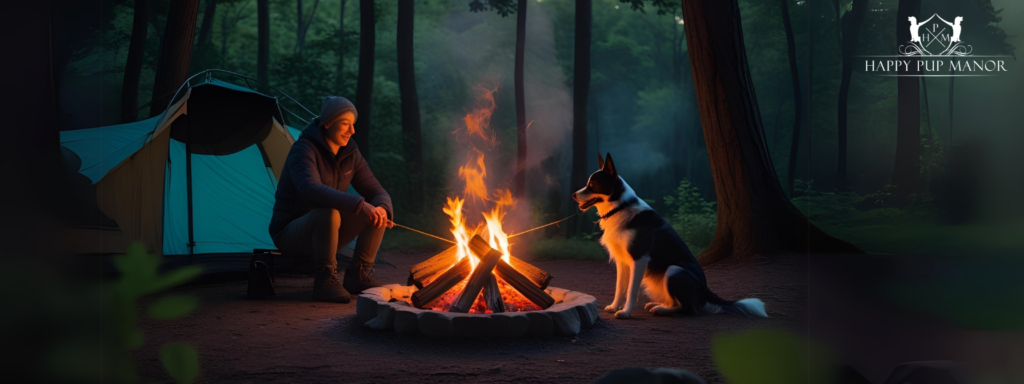
It can, if you are not careful. Just like human food and trash, dog-related items can easily attract bears and other wildlife to your campsite. Dog food, treats, bones, waste, and even the scent left behind on bowls or bedding can pique a bear’s curiosity. To reduce the risk:
Store all scented items
Store all scented items in bear-proof containers or inside your vehicle when not in use. This includes your dog’s food, treats, bowls, and even chews or toys with food residue.
Feed your dog away from your sleeping area
Feed your dog at a distance from where you sleep and clean up immediately after meals. Do not leave food out, even for a few minutes.
Pack out all dog waste
Pack out all dog waste (see our tips above) and keep your campsite clean and odor-free.
Always supervise your pup
Keep your dog on a leash, tether, or within a secure pen at all times. Dogs allowed to roam off-leash can unknowingly agitate or attract wildlife.
If you’re camping in bear country, it’s a good idea to review local guidelines or park regulations about wildlife safety. Many public lands post specific recommendations for campers with dogs.
Final Tips for a Pawsome Camping Trip
Start with short overnight trips
Build your dog’s confidence by starting with a short overnight camping trip before committing to a longer adventure. This gives your pup a chance to adjust to the new sights, sounds, and routines of camping.
Practice basic obedience in distracting environments
Before your trip, brush up on your dog’s obedience skills, especially in outdoor and high-distraction environments. A solid recall, leave it, and stay can make all the difference in keeping your pup safe at the campsite.
Bring familiar comforts
Pack your dog’s favorite toys, blankets, and bed to help them feel secure and relaxed in a new environment. Familiar items can ease anxiety and help your dog settle at camp.
Prioritize hydration
Bring plenty of fresh water for both you and your dog, and encourage regular water breaks throughout your trip. Staying hydrated is especially important when hiking or spending time outdoors.
Most importantly, have fun and bond
Camping with your dog is a beautiful way to experience nature together and strengthen your bond. With thoughtful preparation, your adventures can become cherished memories for both you and your pup.
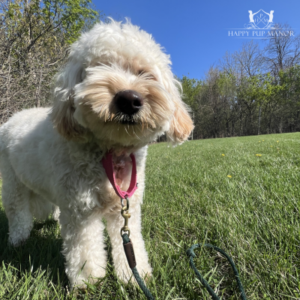
So pack your bags, leash up, and head for the woods. Your pup will thank you with wagging tails and happy, tired paws!
Looking for extra peace of mind before your adventure?
Consider enrolling your dog in one of our Happy Pup Manor obedience training programs before you go camping. A well-trained dog is more confident, safer, and ready to enjoy the great outdoors right alongside you.

